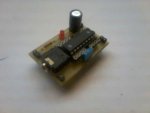I have been using a 433MHz link for some time with no problems. Moving it to an enclosure with a dedicated AXE 133Y display caused a malfunction so I assumed I had broken something.
In the end I loaded this code into the transmitter :-
And this in the receiver module.
Without the display connected, sertxd shows expected results. Connecting the display - even just the neg and pos - causes the Rx to stop.
Supply volts measure 4.99 volts without the display and 4.97 volts with the display
Moving the picaxe output to my "static" AXE 134, (20x4) unit on my development board produces perfect results. The 20x4 follows sertxd faithfully.
The AXE 133 "suspect" unit works perfectly on all my other projects.

Russ
In the end I loaded this code into the transmitter :-
Code:
'18m2
'17/07/12
#picaxe18m2
b0=0
do
b0=b0+1
gosub sendit
pause 5000
loop
sendit:
high c.2
setfreq m4
SerOut c.2,T600_4, ("UUUUU") 'wake up Rx
serout c.2,T600_4,($AA, $BB, $CC,b0) 'Output data to TX
low c.2
return
Code:
'18m2
'17/07/12
#picaxe18m2
symbol LCD=b.4
symbol ANT=c.1
serout lcd,n2400,(254,1) 'CLS
b1=0
do
b0=1
gosub Rec
loop
Rec:
serin ANT,T600,( $AA, $BB, $CC ),b0 'Get data
pause 100
serout LCD,N2400,(254,128,"Count = ",#b0) 'Display it
serout LCD,N2400,(254,192,"Loop ",#b1)
if b0=255 then let b1=b1+1 'Increment loop counter
endif
sertxd ("Count ",#b0,cr,lf) 'Also send tp PC screen
sertxd ("Loop ",#b1,cr,lf)
returnSupply volts measure 4.99 volts without the display and 4.97 volts with the display
Moving the picaxe output to my "static" AXE 134, (20x4) unit on my development board produces perfect results. The 20x4 follows sertxd faithfully.
The AXE 133 "suspect" unit works perfectly on all my other projects.
Russ

